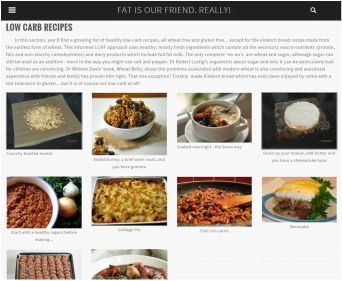Overall low-carb, high-fat (LCHF) guidelines Cheese; an LCHF delicacy; wine optional Cheese; an LCHF delicacy; wine optional
Your first step is to steadily reduce the proportion of carbs (sugars & starches) in your diet, replacing them with vegetables (mostly those growing above the ground), nuts, berries, meat and seafood.
Vegetables contain carbohydrates too but far fewer than in cereal crops, so bread, muesli and most breakfast cereals are the first to go! Orange juice too... it's full of sugar. Create a new balance Your protein, in the form of meat, fish and eggs, tastes even better with healthy salads and your selection of fresh vegetables. As a good basic guide, those vegetables growing above the ground are lower in carbs than root vegetables so potatoes should be limited to use as a salad ingredient. On the other hand, sauces made with butter and cream are welcome. Things will be different! Eating 'spaghetti' bolognaise made with courgette (zucchini) and squash noodles may at first sound like a turn-off but you'll be surprised how good it tastes and how quick they are to make! STEP 1: Stop eating bread, wheat based cakes and all pastries. STEP 2: Reduce any added sugar in stages till it's mostly just there in fresh fruit when you eat it. STEP 3: Avoid all highly processed foods including fast-food. Easy to prepare recipes Lots of recipes to help you start, on this website. Lots of recipes to help you start, on this website.
It will be no surprise; there are lots of home-made, easy to prepare recipes using basic staple ingredients and fresh meats and vegetables that are many times healthier for you than the usual food industry fare.
When it comes to fat: avoid oils containing trans fats like margarine or canola oil which generally contains small quantities of trans fats; avoid commercial sunflower oil, safflower oil, soybean and corn oil (particularly when frying) too and eat healthy oils such as olive oil, flaxseed, avocado or coconut oil/butter. Dairy butter and its close relation ghee are good as is cooking with lard, beef dripping or goose fat - just like your Grandma used to. And you're only human so - always remember: a little of what you fancy does you good. With an emphasis on the word 'little':)
Useful LCHF tips
Make your Shepherds' or Cottage Pie with a mix of one-third potato and two-thirds cauliflower to create a great taste but with many fewer carbs. Or go the whole way and mash your cauliflower with a little butter, grated parmesan and cream cheese for the topping - It's delicious, really low-carb and... I've eaten this way for years:) |
Fat is our financial friend too!
Accepting this simple fact allows you to eat cheaper cuts of meat. Admittedly, at first sight, wheat and corn based products in packages often look cheaper but remember, even the wheat in breadcrumbs acts as a mild opiate to the brain and causes you to eat more than you need or really want to. So skip the over-priced 'leaner mince' and go for the bulk standard one... and if the quality premium is not too high, go for meat and dairy marked 'from grass fed animals'. For a weekend meal, choose stewing steak - the fat breaks down with slow cooking as you turn it into a beef bourgignon or a spicy Moroccan tagine. Choose the cheese you like best. Most of them have a fat content of 25-35% and importantly, you will feel fuller after eating this higher fat content foodstuff - but skip the crackers unless they're low-carb. Splash a little more olive oil onto your salad dressing and don't feel guilty. Because an equal amount of fat weighs just more than twice as much as the same quantity of bread, sugar, pasta or other carbohydrate, you will be eating more calories. But that's OK! You will feel fuller faster; you're eating healthy real food and you crave fewer in-between meal snacks (if any); your stomach and brain will thank you for reducing your processed food intake. One fat to avoid - trans fat
Trans fats are made by adding hydrogen to vegetable oil through a process called hydrogenation, which makes the oil less likely to spoil. In manufactured foods, it helps them stay fresh longer and increases their shelf life or sell-by date (think margarine). Scientists think that it is the process of adding hydrogen to oil that makes the oil more difficult to digest. Although their use is declining, many commercially available foods from biscuits and cakes to frozen French fries still contain trans fats. Most margarines also contain trans fat, although in recent years, food manufacturers have begun to use it less because of the health concerns. You can find the trans fat content on nutrition labels by looking for the words "partially hydrogenated" vegetable oil, a frequently used term for trans fat. For the record (and hopefully not being too pedantic), "fully" hydrogenated oil does not contain trans fats and although small amounts of trans fat occur naturally in some meat and dairy products, the trans fats in processed foods are artificially produced and considered to be the harmful ones. Best to simply avoid highly processed foods. |
